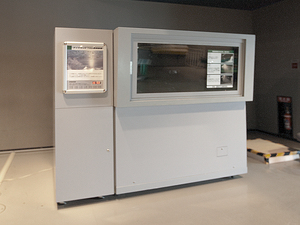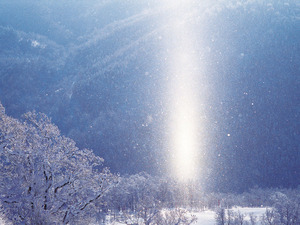Nagoya City Science Museum
TOP > Exhibition Guide > Floor Map> The "Diamond Dust" Experiment
The "Diamond Dust" Experiment



Purpose of Exhibition
This exhibit had been removed.
Artificially reproducing "diamond dust" rarely seen in the natural world, this is an experimental device to understand its formation process. This is an improved device based on the one which was used in the "NGK Water Lab" of the World Expo 2005 in Aichi
Additional Knowledge
[Let's take a closer look at an experiment]
The experiment with this device begins by emitting mist into the air cooled down to -29 _C. Since the mist is an extremely tiny particle of water, it looks like it becomes ice immediately in the air below the freezing point. However, it does not get frozen but floats on in the air. The state of not being frozen below the freezing point is called "supercooling". Since this state is unstable, when stimulated, it becomes frozen instantly. Then compressed air is emitted to the supercooled water particles. When emitting the air, the bubble packaging called "Air Cap" or "Puchi Puchi" is used. If you remain quiet during this experiment, you will be able to hear the sound that is produced when popping the bubble wrap. This leads to making a myriad of microscopic ice particles (ice crystals) where it was foggy.
Over time, the diamond dust starts to look colorful and starts shining. As ice particles take in vapor around them, growing plate crystals in a hexagonal shape, the light reflecting inside and on the surface of a particle looks colored (interference color). It is the same reason why bubbles appear colored.
[Natural Diamond Dust]
"Diamond dust" is a word coined in Japan. The state in which tiny ice particles flying down from the sunny sky are glittery and shiny could been seen as if they were diamond powder fluttering down. In general, it is said that a tiny small ice crystal made of sublimated water vapor in the air is "diamond dust". (Meteorological Agency) On the other hand, there is another theory that diamond dust is produced when it turns into fine droplets for a moment due to condensation of water vapor. In this experiment, although ice crystals are created from fog, since the created ice particles are identical to those in a natural world, it may be safely assumed that they are called "diamond dust". You can see diamond dust on earth in places where the wet air freezes down to -15 _C. However, it cannot be seen unless light strikes. It is very difficult for us to reproduce this phenomenon in an experiment, which can rarely be seen even in nature. Therefore, this experiment could also fail sometimes. We ask for your understanding if any failure occurs.
Article by Shoji Nishimoto, curator
